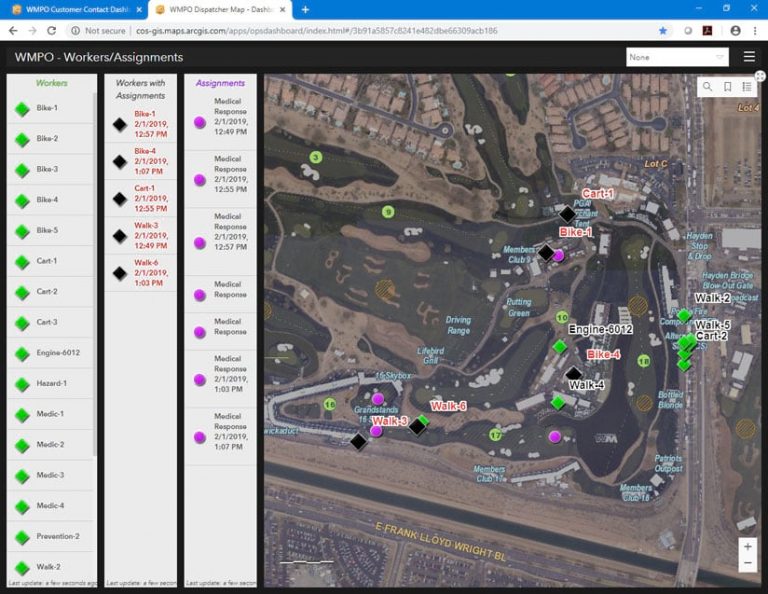Scottsdale Fire Department Switches from Paper Maps to Esri Apps to Manage and Respond to Emergency Calls at PGA Golf Tournament Event
Once a year, the renowned and picturesque TPC Scottsdale golf venue in the Sonoran Desert northeast of Phoenix, Arizona turns into an energetic mini city.
Over four days in late January and early February, more than 700,000 people converge on the complex to attend events associated with the Professional Golf Association (PGA) Tour’s Waste Management Phoenix Open (WMPO). Many follow and cheer on golfers like Rickie Fowler and Justin Thomas who compete in the golf tournament. Attendance is usually the highest on Saturday, with more than 250,000 fans inside the venue.
With a crowd that numbers in the hundreds of thousands, there are bound to be medical emergencies. Scottsdale Fire Department (SFD) paramedics respond to a range of incidents, including slips, trips, and falls; heatstroke; dehydration; and heart problems.
City of Scottsdale departments work collaboratively to plan and coordinate logistics, security, and safety efforts for the WMPO and associated activities. As deputy chief of SFD, Robert Rucker has delivered emergency medical services at the golf tournament for many years. For 2019 planning, he knew there had to be a better way to manage situational awareness and respond to medical emergencies rather than using long-held methods that relied largely on remembering past events and consulting paper maps of the tournament grounds.

Rucker then saw an Esri video showcasing the use of ArcGIS technology by Henrico County, Virginia, to manage public safety at National Association for Stock Car Auto Racing (NASCAR) events. He saw how the technology enabled real-time visibility across all areas of the race track—facilitating more efficient and effective response to incidents—and said, “I want that!” Convinced of the benefits of breaking tradition, Rucker was eager to introduce the new technology to his department.
Rucker reached out to the city’s geographic information system (GIS) department, led by manager Chris Lechner. Lechner’s team plays a key role in providing GIS services to all city departments, including SFD. From his team, Lechner enlisted GIS analyst Mele Koneya for assistance in researching which GIS solutions would be needed.
The department used Esri ArcGIS technology to do the following:
- Collect data for and create a digital map of the venue
- Provide situational awareness for the event
- Help paramedics find their way to the location of each incident

Cooperative Planning
Lechner and Koneya contacted Mike Cox, director of fire and emergency medical services (EMS) solutions at Esri, for his input. Cox, a former fire chief for Henrico County, had supported the NASCAR event. Cox coordinated talks with staff from Henrico County as well as the City of San Antonio, host of the National Collegiate Athletic Association (NCAA) Final Four basketball playoffs, for insights and recommendations for deploying ArcGIS software-based solutions for event situational awareness. From those discussions, several ArcGIS field operations apps—including Survey123 for ArcGIS and Workforce for ArcGIS—were identified as the ideal technology for managing emergency medical response by SFD at the WMPO.
With a general strategy in place, Lechner and Koneya worked closely with SFD battalion chief Andy McDonald, system integrator David Getz, and SFD division chief Kerry Swick to define the tactics for success.
“If you’ve ever worked with firefighters, you know they’re pretty [much] Type A [personalities],” McDonald said. “Give them an assignment and they’ll take it and run. They rely on what they know works for them and they don’t like change.”
It was clear that whatever technology was put into the SFD responders’ hands had to be easy to use and not slow anybody down.
Planning for the new technology needed to start well in advance of the golf tournament. For several months preceding the event, a flurry of activity takes place to install the significant temporary infrastructure required for such a large production: hundreds of vendor booths, a 25,000-plus seat grandstand at the sixteenth hole, scoreboards, and other equipment and amenities. Year after year, the infrastructure expands to meet the demands of an event with attendance that’s booming.
Many of the firefighter/paramedics at SFD are familiar with the grounds and course layout at TPC Scottsdale, having worked at the WMPO in the past. When dispatched to an incident, a paramedic would rely largely on memory and a small paper map of the event layout to determine the quickest path to reach the person who needed attention. Often, the dispatcher would reference well-known landmarks to help guide paramedics to an incident location. For the new digital strategy to be effective, a comprehensive and accurate digital map of the venue was a key requirement.

Teeing Up the Map
From PDF drawings provided by The Thunderbirds, the event’s sponsor, a map layer of the corporate venues—which contain more than 500 individual suites—was created and added to an existing digital basemap of the event site. Next, McDonald, Lechner, and Koneya—using the form-based data collection application Survey123 for ArcGIS—collected location data on additional structures and assets such as concessions, restrooms, and scoreboards. As data was collected, it fed directly into ArcGIS, providing precise location information for each newly added asset. Using the app, the precise locations for the assets that were already on the map were verified and corrected as necessary.
Survey123 for ArcGIS provided a quick and easy-to-use means of collecting accurate data. Having more comprehensive, accurate data on the map meant that everyone had precise information and reference points for locating any spot within the event venue.
The new digital map, which was created using ArcGIS Pro, was published in ArcGIS Online. That map was then used in Workforce for ArcGIS, a field workforce-coordination app, to plan where to strategically position paramedic units staffed by SFD personnel who walk, ride bikes, or drive carts. While dispatching the firefighter/paramedics, McDonald could now select the closest, most appropriate unit based on the incident type and monitor the unit’s status.

Apps on Course
As the golf tournament got under way, McDonald was in the communications room on-site, ready to dispatch up to 25 SFD paramedic teams of two, positioned throughout the venue. Calls came to McDonald from multiple sources via the emergency medical system channels—911, the Public Safety Answering Point (PSAP) app, Scottsdale Police Department, and WMPO event security—and he then efficiently radioed the nearest appropriate unit.
As McDonald dispatched calls over a two-way radio system, paramedics used Workforce for ArcGIS to report their status: busy, on break, or available. With the digital event map on the same iPad devices that the paramedics use to reference medical care software, it’s easy for them to access location information for the entire venue and to zoom in on an area for greater detail, if needed.
Off-site, at the Scottsdale Emergency Operations Center (EOC), a comprehensive view—built with Operations Dashboard for ArcGIS—of the paramedic units was displayed on one of the large monitors for the benefit of local agency executives managing situational awareness for the tournament. The dashboard displayed real-time information about paramedic calls, easily identifying areas with the most activity, the disbursement of paramedic units, and the number of each type of emergency call that had been taken or was in progress. The information on the dashboard provided insights that had never before been available in real time.
“[The executives] were able to look at the dashboard and watch what we were doing. They liked having that information in front of them on a computer,” McDonald said.
According to McDonald, Workforce for ArcGIS offered three main benefits. “Safety of my EMT crews was the number one benefit,” he said. “Next was the ability to allocate the appropriate resources—sending the nearest crew to a call. And finally, [it was important] to see, in real time, where my crews were located.”
In addition to using the Workforce app, the paramedics employed a simple survey—created with Survey123 for ArcGIS—to document nonemergency contacts at the event. The paramedics added information to the survey when they provided water, sunscreen, directions, and cart rides to attendees in need. The data captured in the survey was viewable on Operations Dashboard for ArcGIS to show what types of nonemergency services SFD provides, in addition to medical care, during the week of the golf tournament.

